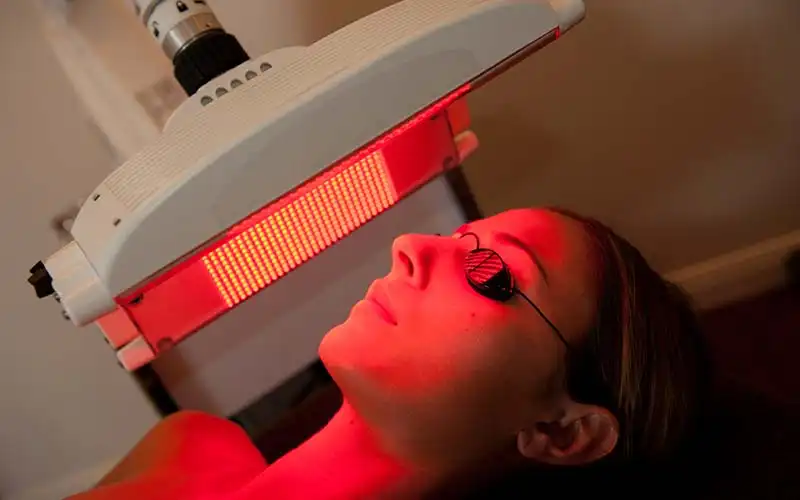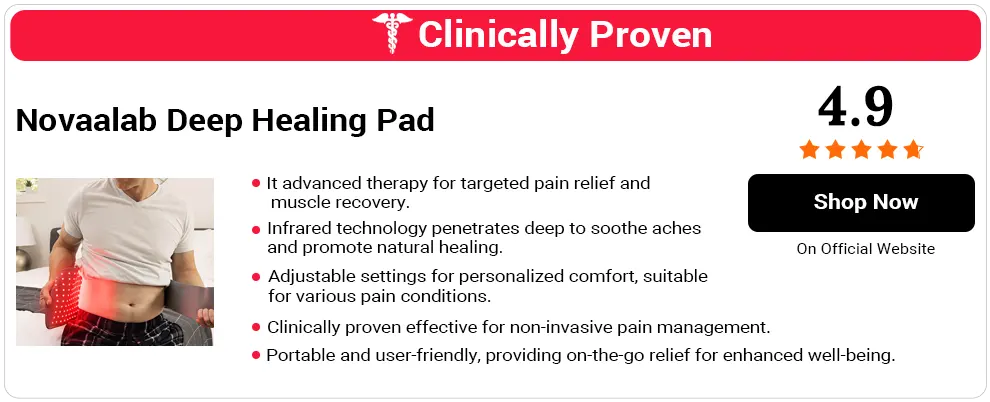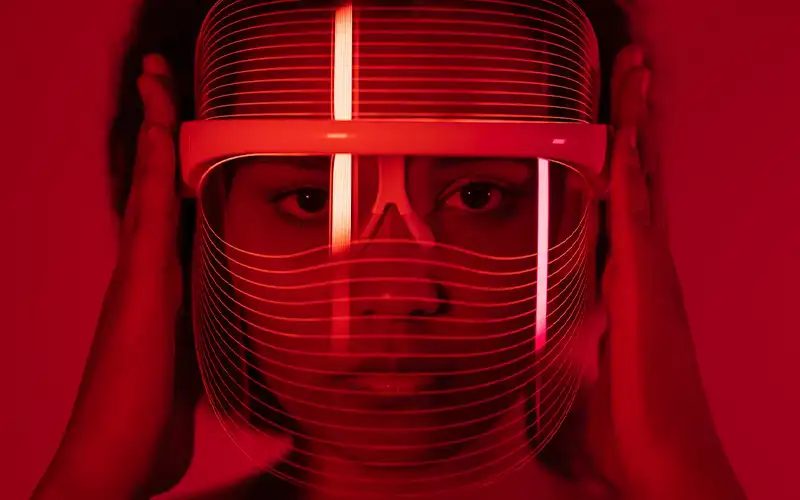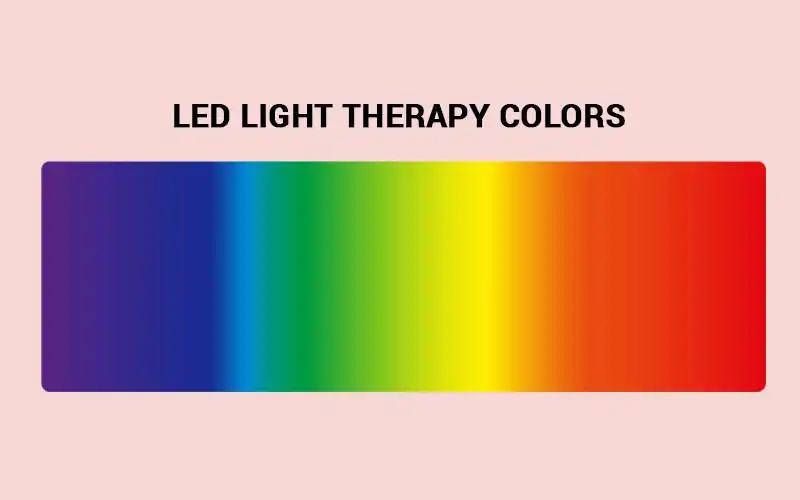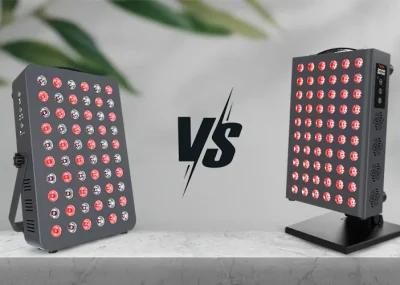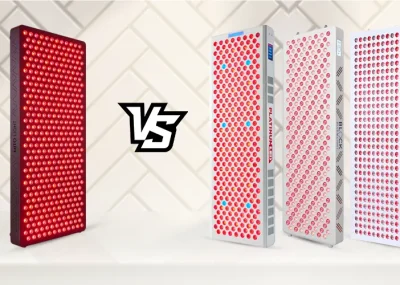Overview: Red Light Therapy and Safety
If you’re already using or are in the market for a red light therapy at home device, you may be wondering about the safety of this treatment and whether you may experience any side effects.
According to the research, if you follow the proper treatment guidelines LED light at the wavelengths used in high quality home devices is safe and has limited side effects.
However, it’s important to consider factors like the sensitivity of your skin, whether you are taking medication, and the timing of the treatment. In this article we’ll tell you everything you need to know about LED light therapy and its potential side effects.
What Wavelengths Make Up the Electromagnetic Spectrum?
The unit of measurement for the electromagnetic spectrum is nanometres, and it ranges from UV light at 10-380 nm to infrared light at 900-1400nm with a range of colors in between. These include violet, blue, green, yellow, orange, red, and NIR infrared.
Red light therapy devices never use UV light, as it can damage the skin, promote premature aging, and leave you at risk for developing skin cancer.
The most commonly used wavelengths in LED light devices are blue (450-495nm), red (610-700nm), and NIR infrared (700-900nm). According to board-certified dermatologist Nina Desai, “Red light therapy is considered relatively safe, because the spectrum of light is not in the UV spectrum [1].
You may see some of the other colors like green, yellow, orange, and violet included as options in a LED light facial mask, as they offer a number of dermatological benefits. Evidence shows that these wavelengths are mostly safe and have limited risk. Have a look at our article recommending some of the best, safest dermatological masks on the market.
What Are The Potential Side Effects?
While red light therapy is a safe technology on the whole, there may be some limited side effects associated with it. Let’s look at the 3 main colors used: red, blue, and NIR-infrared.
Blue
Blue light therapy is a common treatment for acne, as it can kill the bacteria that causes the condition, reduce redness, and decrease inflammation. It also helps stimulate the brain, for enhanced awareness, concentration, and mental energy.
However, blue light can be disruptive to our circadian rhythm, which is why you should avoid use at night. It could disrupt your sleep-wake cycle and lead to difficulty sleeping.
We get a lot of blue light throughout the day with the many devices we use, so we advise that you not overuse this wavelength beyond the stipulated treatment guidelines. When you do use it, wear protective glasses that limit the transmission to your eyes.
An article in Molecular Vision by Gianluca Tosini, Ian Ferguson, and Kazuo Tsubota discussed the potential effect of blue light on the circadian system and the eyes [2].
There are some other possible side effects of blue light, including mild headaches, poor mental focus, and limited attention span.
Red and Infrared
The research shows that red LED light therapy and NIR infrared light are safe and have very limited potential risks or side effects if you use the device according to the directions. Occasional symptoms may include headaches, strain to the eyes, sensitivity to light, or tighter skin.
However, these are uncommon. If you do experience these issues, you may want to cut down on your treatment time and/or frequency or consult with a physician for advice as to whether or not to continue the sessions.
It’s important to note that infrared light over about 850nm can lead to side effects like burning skin or even damage to the retina or organs. However, you should not find these wavelengths used in at home light therapy devices.
What Does the Research Say?
There are numerous studies highlighting the benefits of red light therapy which also show that it is safe and has very limited adverse effects. These are some of the many examples:
- A study published in the Journal of Cosmetics, Dermatological Sciences and Applications by J Shaoul and R. Stephen Mulholland showed that an at home LED red light device plus mild heating effectively improved photoaged skin with no adverse effects [3].
- Researchers J Stelian, I Gil, B Habot, M Rosenthal, I Abramovici, N Kutok, and A Khahil looked at the effects of low level light therapy on elderly patients with knee osteoarthritis in their study published in the Journal of the American Geriatrics Society. They concluded that it was both effective and safe at reducing pain and discomfort [4].
- Is red light therapy safe to use on your eyes? Studies shows that it is safe at red and NIR infrared wavelengths from 630-830nm.
- As an example of supporting research, a 5 year follow up study published in 2018 in the Journal of Physics looked at the effects of low level light therapy on patients with age-related macular degeneration [5].
- Researchers K Koev, et al found that it improved visual acuity and led to no long terms side effects or risks.
Who Should Avoid Red Light Therapy?
There are some contraindications for the use of LED light therapy. It’s best not to use the treatment on areas with open wounds, skin lesions, or tumors on the skin.
However, consult with your physician first. A study published in Photomedicine and Laser Therapy by Max Myakishev-Rempel, Ph.D. and Istvan Stadler, et al showed that red light at 670nm twice a day for 37 consecutive days was safe even when there were malignant lesions, and did not impact tumor growth [6].
There are also medications like lithium, antibiotics, melatonin, and certain antipsychotics that you should not combine with this treatment. This is the short list, so if you are taking any over-the-counter or prescription pills check with your physician before beginning LED light therapy.
There may also be certain conditions that preclude use of this treatment, so again, get approval from a doctor if you have a serious medical issue.
We covered a review of Mitored pro, this red light therapy covers skin benefits, improves exercise performance, and boosts brain health.

How to Follow Safe Red Light Therapy Treatment
Safe use of your device will depend on the product and the specific treatment you are seeking. Read the user’s manual that comes with your product carefully, following the guidelines for safe distance from the product, treatment times, and number of sessions per week carefully as we explained in our review of the Red Light Man brand.
We reviewed an article called theralight fit which helps in improving skin elasticity, nerve pain, muscle recovery, and tissue healing with safety and efficiency.
An average course of treatment will likely involve treatments spanning from 5-30 minutes about 3-4 times a week, but as we’ve said, it varies based on the device and the treatment issue. Understanding the recommendation of red light therapy dosing is crucial to optimizing its benefits and ensuring safety. The duration and frequency of sessions can influence the effectiveness of the treatment, so it’s essential to adhere to the recommended dosing guidelines.
Red light therapy is safe for the eyes, but some people feel the need to wear protective goggles during their treatment. Most products come with red light therapy goggles for eye safety, and you can choose to wear them or not based on your preference.
How Do I Choose a Safe Red Light Therapy Device?
When selecting a red light therapy at home device, ensure that you purchase from a known, well regarded manufacturer with a reputation for making safe, high-level products. Their devices should be FDA cleared, and follow strict safety standards in production and testing.
As we explained in our article about the cognitive benefits of red light therapy, the safest devices have zero EMF levels, or levels so low that there is no potential risk. Choose a product which uses continuous light, as pulsed light is of less benefit and may cause side effects like nausea, dizziness, rapid eye movements, and headaches in some users.
If you have sensitive skin, you can limit potential skin tightening effects by choosing a lower intensity device, or a product which allows you to set the light intensity as you wish.
FAQs
Q: Can You Overdo Red Light Therapy?
A: How much red light therapy is safe? You should always follow the stated instructions as to treatment time and frequency when doing red light therapy at home.
The research about overuse of this technology is not conclusive, and while LED lights are safe, there’s a chance that too long or too frequent sessions could damage the skin or cause small burns.
Q: What Are The Negative Effects Of Red Light Therapy?
A: LED light therapy with the typically used wavelengths – red, NIR infrared, and blue is quite safe and has few negative effects for the vast majority of individuals.
You should not use blue light at night, as it could disrupt your circadian rhythm and cause sleep issues, and it may also negatively impact concentration. In some people it could lead to mild issues like headaches or nausea.
There may be some infrared light side effects if you use wavelengths of over 850-900 nm. It could cause burns or damage to the skin, harm your eyes, and possibly impair other organs.
However, the devices on the market rarely offer this as an option.
Wraps and facial masks could lead to hot spots on the skin in some rare instances, so be sure to follow the correct instructions for use to minimize this possibility.
Q: Do You Need To Wear Goggles With Red Light Therapy?
A: You don’t have to wear protective red light therapy safety goggles, as the technology is fine for your eyes. However, if you feel better doing so, it will not limit the effectiveness of the treatment in any way.
Q: Are Devices With EMF Emissions Safe?
A: EMFs are electromagnetic fields that come from power sources like AC adaptors. While research shows they are not harmful at the levels emitted by household products, there are guidelines as to how much different devices can safely emit.
Any safe LED light therapy device will have either zero or undetectable levels of EMFs, so be sure to check this before you buy.
Conclusion
If you were wondering about possible dangers of red light therapy, you should know that this technology is safe, non-invasive, and has very limited side effects when used correctly.
These devices do not emit UV light, so the risks to the skin and body are very minimal for the common wavelengths used: blue, red, and NIR infrared light, and sometimes violet, blue, green, yellow, and orange.
Looking through the red light therapy reviews for the top brands, you’ll find very few if any reports of side effects from the treatment, and a wealth of feedback about the positive benefits the devices offer for health and wellbeing.
Wondering about the safety of red light therapy? Rest assured, when used correctly, it’s a safe, non-invasive method with minimal side effects. You can explore the benefits of red light therapy at home with confidence, and devices from reputable manufacturers like Body Wisdom ensure FDA clearance and adherence to strict safety standards.
We also covered the Biomax 450, LED therapy lights this benefits to improve mood and reduce pain as well as brain health the best part is this red light therapy is FDA approved with no side effects.

